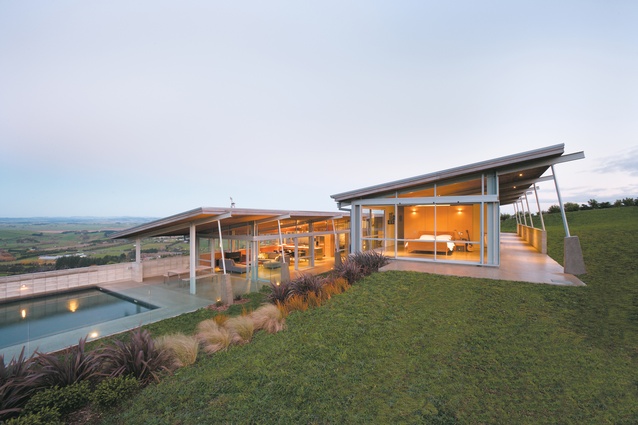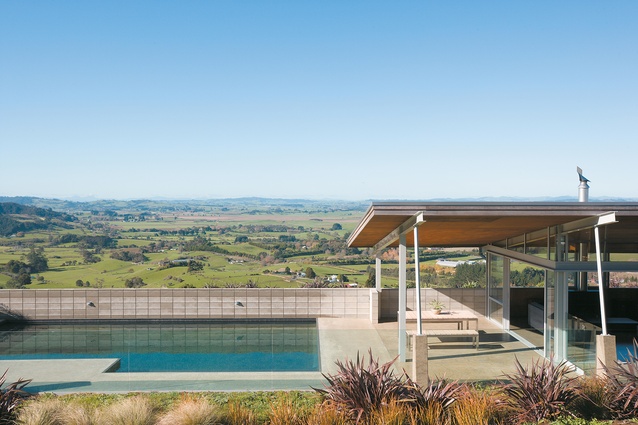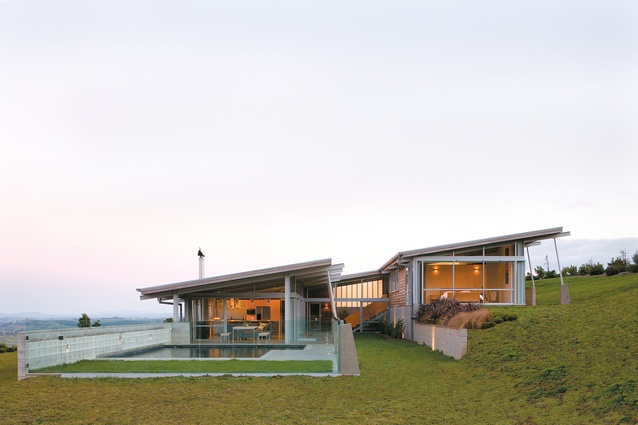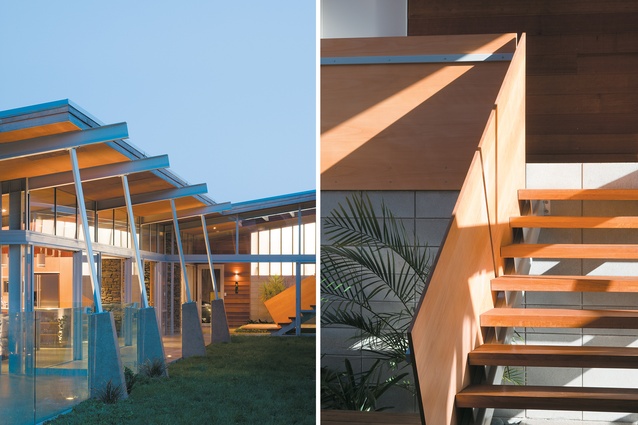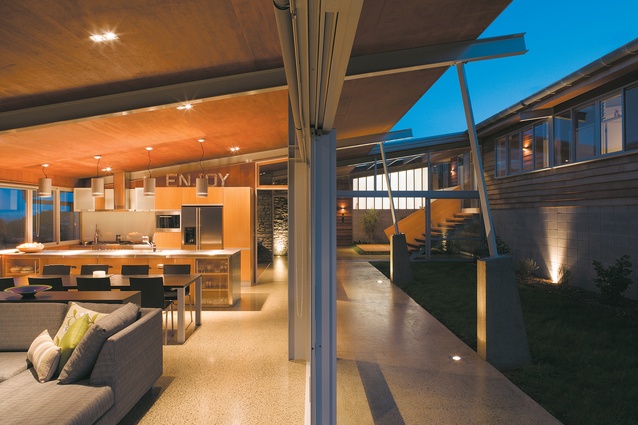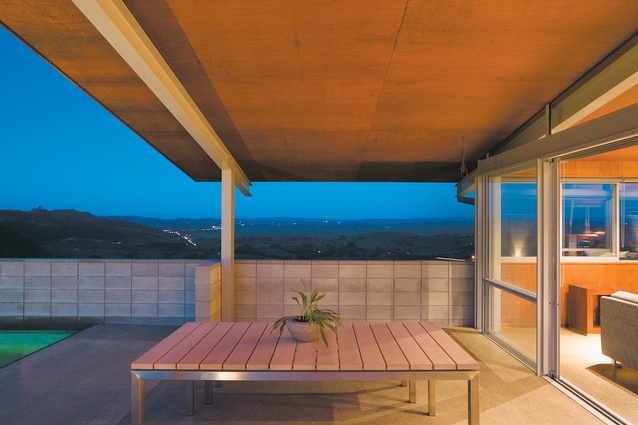Houses Revisited: Higher plane
From September 2007: On an exposed site with a huge panorama, Strachan Group Architects (SGA) provides shelter and dissolves boundaries.
When Rob and Sally Nichol bought a section on the back of the Bombay Hills just outside Pokeno, 50 kilometres south of Auckland, they knew they had a difficult spot on which to build a new home. Situated near the crest of a hill, the section looks down on the little church where the Nichols were married and boasts panoramic views of the Whangamarino wetlands to the south west, the same direction from which the prevailing wind blows up from the valley floor.
How could they maximise the views, create usable outdoor spaces and still protect the house from the prevailing wind? This was the brief that the Nichols presented to Dave Strachan of Strachan Group Architects (SGA), an Auckland-based practice that aims to “create a contemporary architecture of place that captures the essence of living in New Zealand” – in all of its cold, beautiful blusteriness.
In designing an “architecture of place” SGA could not have done better. The house consists primarily of two long, low forms separated by a narrow courtyard; the lower form contains the house’s public spaces – kitchen, living, dining, TV room and office – while the upper one contains the private spaces – bedrooms, bathrooms and a gym room. According to Martin Varney, who teamed with Dave Strachan on the project, these forms allude to the farm sheds in the surrounding hills, a reference echoed in the mooing of nearby cows. Like these sheds, the Pokeno Foothills house clearly expresses its simple structure. The architects treat materials with a light, yet refined hand: thick schist walls mark the entrance to the house, Meranti plywood ceiling panels are clear-sealed and left exposed, and detailing exposes joints rather than concealing them.
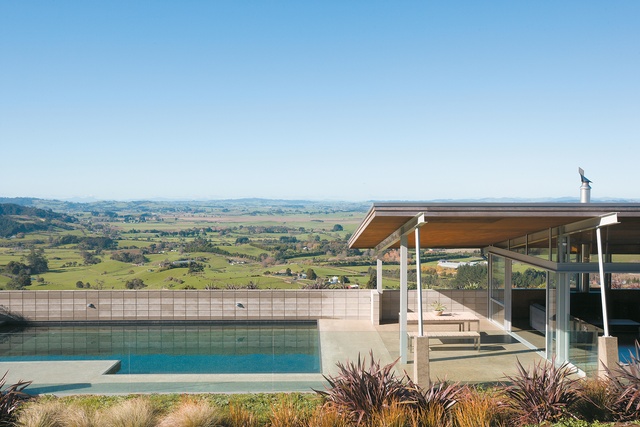
The house’s mono-pitch roof seems to be lifted out of the hill itself, the tilted angle of its steel supporting columns expressing the enormous effort of the task. By treating the roof as a single plane pulled down low to the ground on the valley side and lifted up high on the hillcrest side, the architects elegantly solve the problem of protecting from the wind while preserving the view. The angled roof directs the prevailing wind up and over the house, while the long, low southwestern façade presents a minimal surface to be buffeted.
On approaching the house, this façade appears as a cold, hard barrier of steel, concrete and glass, save the inviting warmth of the wooden front door. From the inside, however, the wall dissolves into the view, which is admitted in its entirety through a long ribbon window that runs the length of the kitchen, dining and living area. While the front façade hunkers down, the rear façades reach upwards, their double-glazed surfaces admitting ample sun to warm the polished concrete floor slabs.
The long 6-metre-wide courtyard separating the upper and lower ‘sheds’ provides a wind-free outdoor space habitable the year round and serves as a buffer between the public and private parts of the house. To the west, the courtyard opens to the view of a bush-covered hill in the neighbouring forest reserve. To the east, it continues through a glazed external wall and into the house, where it creates an intriguing ‘room’: an interior courtyard with a raft-like, Eucalyptus wood deck that floats among a small sea of plants. Is the courtyard an internal or an external space? It seems to hover somewhere between the two. Several details heighten this ambiguity: thick Glen Ida schist walls that lead into the space from the entry; the continuation of Western Red Cedar weatherboarding from the outside to the inside walls; the absence of jambs on doors that open onto the space; and the extra-wide staircase that doubles as seating.
The architects play with similar ideas in the master bedroom at the western end of the upper ‘shed’. Here, they dissolve traditional boundaries to bare the house’s most private space. All three of the room’s exterior walls are fully glazed; two of the rooms have sliding doors that, when fully opened, dematerialise the distinction between domicile and landscape. The interior wall, a 2.2-metre high freestanding wardrobe, loosely divides the bedroom from its ensuite bathroom.
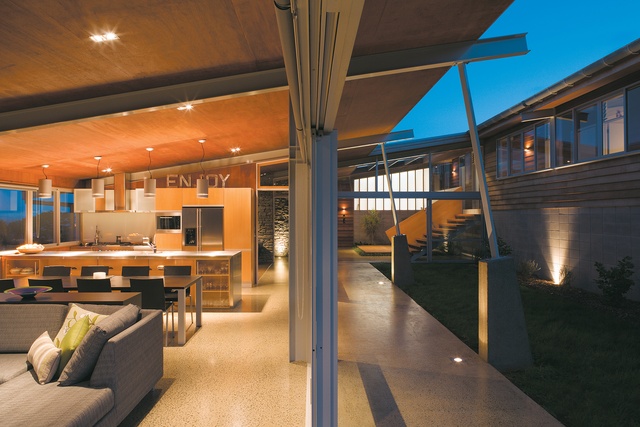
The large, wood-framed glass bathroom door disappears into a wall, and no door separates the bedroom from the hallway. A sliding door in the rear wall of the ensuite bathroom allows one to step directly from the outside back verandah into the shower, stopping only to kick off gumboots. Sally Nichol admits she was concerned about the bedroom’s potential fishbowl quality, but says her fears were unfounded. The room’s exposure is an option, not an imperative. Pull-down screens on the bedroom’s south and west walls and sliding aluminium screens (that let in the breeze) on the north wall, provide privacy and security.
With a brief as straightforward as the one the Nichols presented, SGA might have allowed the design to become a textbook exercise in meeting functional requirements. That functional requirements have been met is evident in the fact that the house is a lovely place to take in the view on a cold winter day. That functional requirements have been exceeded is evident in the fact that the Nichols have rarely had to make use of their underfloor heating system. But the Pokeno Foothills house extends the clients’ brief, incorporating into it ideas about the creative and expressive potential of architecture. More specifically, the house reveals a sense of playfulness with respect to traditional notions of internal/external and protection/vulnerability. SGA have created a country house that, literally and figuratively, arises from the land, and relates to its surroundings in the very simplicity of its fundamental design moves.
Click here to see more Houses Revisited. And sign up to our email newsletters to receive Houses Revisited straight to your inbox.
Note that, since the time of publication, the architecture firm mentioned may have changed name, personnel or both.

